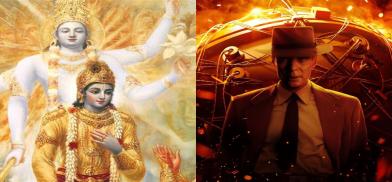“Oppenheimer” and the Bhagavad Gita: How the Hindu scripture became the American physicist's moral compass
There was something profoundly moving to note that a deep philosophical insight given by Krishna Dvaipayana better known as Ved-Vyasa, the creator of the Gita and the Mahabharat, many millennia ago, should come to underpin the most defining event of the 20th century and beyond.

Either by design or default Christopher Nolan’s Oppenheimer in the sprawling epic, which is a box-office hit even in India, feels constantly reminiscent of the Mahabharat’s Arjun profoundly conflicted on the precipice of an impending massacre.
Cillian Murphy’s haunting portrayal of Julius Robert Oppenheimer with his often vacant, into-the-horizon gaze only accentuated for me the feeling that I was watching Arjun battling his own moral compunctions over what he was about to embark on. Unlike Arjun, who had Krishna to help him scythe through his unwieldy dilemmas, Oppenheimer had no personal guide. Perhaps it was in that gaping vacuum that he turned to the Bhagavad Gita, Hinduism's most revered scripture, for resolution.
Oppenheimer’s engagement with the Gita was active during the conception and execution of the Manhattan Project from 1941 onward which created the world’s first atomic bomb test on July 16, 1945, at Trinity Site near Alamogordo in New Mexico.
Nolan’s movie has several layers, many of which overlap while many run parallel. Like all his other movies, the director assumes a level of intelligence and attention among his audience and does not go out of his way to make the inherently complicated material palatable at the cost of its deep substance. The movie can come across as both dense and confusing if one is not reasonably familiar with the contours of not just the physics of the Manhattan Project but its deeper, highly troublesome politics.
A feature that struck me is the number of egos crashing into one another in the movie starting with that of Oppenheimer himself along with those of Lewis Strauss, a former chairman of the United States Atomic Energy Commission, Edward Teller, the theoretical physicist known as the “father of the hydrogen bomb, Leslie “Dick” Groves, A US army lieutenant general who worked side by side with Oppenheimer, and even in passing but quite tellingly of President Harry S. Truman.
Arjun-like conflict within
In an extraordinary scene, after the bombings of Hiroshima and Nagasaki, Oppenheimer meets Truman at the White House, visibly overcome with his Arjun-like conflict. As the film shows, Oppenheimer tells Truman “There is blood on my hands.” A remarkably dismissive Truman responds by handing him as if to tell him to wipe the blood off. Truman told Oppenheimer to let him worry about that, adding no one was going to remember who made the bombs but who dropped them. One could sense Truman’s resentment at Oppenheimer having become a much larger global figure than him as captured on the cover of Time magazine. In dismissing the physicist’s mea culpa Truman seemed to assert his giant ego as a figure of greater historical consequence. As if to rub it in one can hear him refer to Oppenheimer as a “crybaby scientist” whom he would not trust.
While I was riveted by all the complexities of producing the world’s first atomic bomb and the physics surrounding it, I watched the movie from the standpoint of Oppenheimer’s Arjun syndrome. Oppenheimer’s dispassionate, almost coldly detached acquiescence to the broader politics of the atomic bomb has been interpreted as a direct result of the way he digested the Gita. He saw it purely in terms of his duty as a scientist and perhaps nothing more.
Much has been written about whether Oppenheimer came to regret having pioneered the atomic bomb. There appears to be considerable agreement that he did not feel remorse in any manifest sort of way. Even during the first successful test in 1945, he was said to have thought of this line from the Gita: “If the radiance of a thousand suns were to burst into the sky that would be like the splendor of the Mighty One.” This was notwithstanding his full understanding of the potential for death and destruction that the enormous power could and would unleash.
Turning to the Gita
It was clear to those involved in the Manhattan Project, particularly someone at its helm like Oppenheimer, that the eventual purpose of the bomb was to be deployed as a weapon very soon. It was in that context that the physicist’s dependence on the Gita as his spiritual guide ought to be viewed.
The Sanskrit verse in question that captured Oppenheimer’s imagination in the aftermath of the successful test was “Kalo’smi loka-ksaya-krt pravrddho”, which has been variously translated. While “Kal” has generally been interpreted as Time and therefore Time being the great destroyer of worlds, there is a widespread interpretation in the Western scholarship about Kal being Death by its very implication. Hence the most popular transliteration as used by Oppenheimer, “Now I am become Death, the destroyer of worlds.” Among the Indian scholars the more acceptable translation has been, “I am terrible time, the destroyer of all beings in all worlds.”
When Murphy says those iconic words onscreen, I found myself mouthing its Sanskrit version almost simultaneously. There was something profoundly moving to note that a deep philosophical insight given by Krishna Dvaipayana better known as Ved-Vyasa, the creator of the Gita and the Mahabharat, many millennia ago, should come to underpin the most defining event of the 20th century and beyond. To top it, it was via the agency of a scientist gripped and almost debilitated by the certainty of the destructive power of what he was about to unleash with the atomic bomb quite like Arjun in the ancient Indian epic tale.
(The author is a Chicago-based journalist, author, filmmaker and commentator. Views are personal. By special arrangement with Indica)









Post a Comment